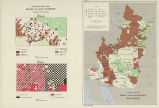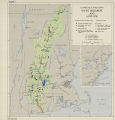| OCR Text |
Conclusions A watershed management program is essential in the basin. It is essential because the lands are deteriorated, and because the condition of these lands has a major and incremental adverse effect upon the water resources. It is essential not only to prolong the useful life of the presently con- structed reservoirs and their associated facilities, but also to safeguard and lengthen the life of other costly developments proposed for the basin. The fact that the bulk of the lands are in public ownership, primarily Federal, and that these pub- licly administered lands are among the most deteriorated lands in the country is not to the credit of national land policy. That the several respon- sible public agencies, Federal and State, have not taken direct and positive steps to cure the long- existing evils with measures now in their own hands, is not to their credit. That trie Federal Government should make and consider making additional large expenditures for water resources development without first taking vigorous action to overcome the situation is unwise. That the States and other local public agencies have failed to protect their properties from continuous decay or safeguard their limited water resources is improvident. The public lands are multiple-pur- pose lands: an important and in many places a dominant use is for water production and sediment control. The situation in the Colorado Basin can be alleviated only by a sound, coordinated watershed management program. This program requires a reduction in the present over-use of the range, im- proved management, more vigorous and conserva- tion-minded land administration by the managing agencies, cover improvement on a large scale em- bodying reseeding of range land and reforestation, better fire control, and many types of supplemental and supporting upstream engineering works on the land and in the channels. Public attitude and public policy toward the public lands of the basin must change. National, regional, and local public interest requires action. The public should demand that all agencies admin- istering lands on behalf of the public manage those lands in the broad public interest, including water and soil control. Legislation, State and Federal, should be enacted which will insure effective man- agement. Only through concerted public interest can water resources activities in the basin go for- ward. 428 General conclusions.-To make water resources development in the basin fully effective, plans for watershed management must be incorporated into programs for the basin presented to Congress, and should include these provisions: (1) Before construction commences on engineer- ing works, surveys first should be undertaken to de- termine the relation of eroding lands draining into a project area, and the sediment which will impair project life. Such a survey should determine, inso- far as possible, the place of overgrazing and other land use practices on the erosion. (2) Effective watershed programs should pro- ceed at least concurrently with engineering con- struction in project areas seriously affected by eroding lands, and where a significant part of that erosion is traceable to depleted watershed condi- tions or to inadequate land use practices. However, in undertaking such programs, con- sideration should be given to the impact on present investments in the livestock industry and on the wel- fare of Indian tribes dependent on their herds for livelihood. Provision should be made for orderly adjustment to a new program to avoid sudden dis- ruption and hardship. No Federal water resources development should be undertaken in any particular State of the basin until the State has adopted a program of conserva- tional management of State and other local public lands. No Federal water resources development should be undertaken in any State unless that State pro- vides legislation adequate for land conservation pro- grams on all lands capable of restoration. In those areas which are proven not to affect exist- ing or proposed engineering projects seriously, it still is important to improve land treatment. On those lands steps should be taken immediately to initiate better land management practices through grazing control, improvements, and other means for preservation and improvement of range lands in all public ownerships-Federal, State, and local-im- plemented by legislation and funds. However, these programs should stand on their own merits as individual components of an over-all program in which each element is fully justified by the bene- fits it will produce. In order to provide a truly "balanced" program, they-along with other elements of the program- should meet the test of existing human need in its broad sense including consideration of the limited national assets of labor, capital, and materials avail- able for investment in such undertakings. Compo- |


























































































































































































































































































































































































































































































































































































































































































































































































































































